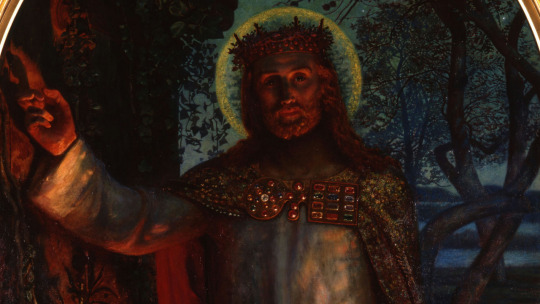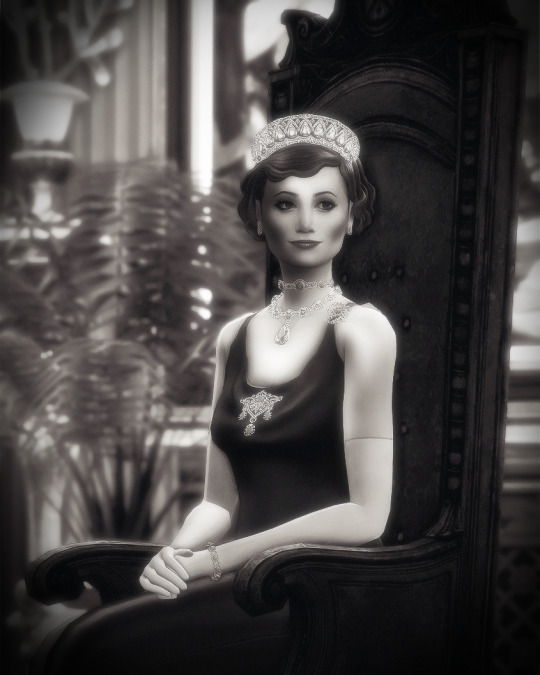#st. heinrich
Explore tagged Tumblr posts
Text






The double tomb of Heinrich II (973-1024) and his consort Cunigunde from 1513. The side panels are decorated with scenes from their lives. Heinrich II was the Holy Roman Emperor from 1014 until his death. Empress Cunigunde buried her husband in Bamberg Cathedral. Heinrich II became St. Heinrich in 1147.
Cathedral of Bamberg.
Bamberg, Germany
Feb. 2023
#tombs of the dead and famous#holy roman emperor#holy roman empire#germany#deutschland#bamberg#st. heinrich#tomb#original photography#photography#taphophile#taphophilia#lensblr#photographers on tumblr#tombs#church#church photography#religious art#wanderingjana
18 notes
·
View notes
Text
Day 11: Sleeping on the job
So, here's the obvious thing: there is a patron saint of those who sleep on the job and her name is Pia.

If you're feeling tired but you still have work to do, you may pray to St. Pia. Rest assured that there is a parallel universe where Pia will fall asleep in your stead (because, yes, that is how patron saints work. they mess around in parallel universes, although they sometimes switch. After all these centuries, their desktops are a complete mess.)

However, this is not the only way in which St. Pia will work her miracles. If you actually have some time to spare, she may grant you a well advised power nap, so you may wake up refreshed and ready to go.
If you don't have time to spare though (because, let's say, an important meeting is due) St. Pia will appear and wake you up, so you may not miss your appointments.



So, when considering which patron saint to invoke next, keep in mind that there is St. Pia. (Luckily, she isn't picky when it comes to offers, so snacks, coffee, fast food - anything is fine).
Praise be. 🙏
#spatort#tatort saarbrücken#pia heinrich#patron saint of those being tired at work#30dtsc#30 day tatort saarbrücken challenge#30 days to spatort challenge#pls take this lightly#I come from a region where especially older folkes attribute a lot of weight to patron saints#and I grew up that way too - mining.. seafaring.. u name it#My grandparents would litterally be like Happy St. Barbara's Day#to me this always felt like a bunch of jinns or Pokemon haha#pls don't come to get me
17 notes
·
View notes
Text
youtube
Johann Heinrich Rolle (1716-1785) - St. Luke Passion: No. 17, Werdet ruhig, ihr Gedanken ·
Hugo Hymas
Michael Alexander Willens · Kölner Akademie · · ·
6 notes
·
View notes
Text

Schweizerische Volksbank (1972-76) in St. Gallen, Switzerland, by Heinrich Graf
79 notes
·
View notes
Text
The Porcelain Maker by Sarah Freethy #ARCReview #NetGalley #BookReview #HistoricalFiction #WWII #StMartinsPress
In this debut novel, readers will learn about the creation of fine porcelain figurines in Germany during WWII under the direction of the leader of the SS, Heinrich Himmler. #ThePorcelainMaker #StMartinsPress #NetGalley #ARCReview #BookReview #WWIIFiction
Germany, 1929. At a festive gathering of young bohemians in Weimar, two young artists, Max, a skilled Jewish architect, and Bettina, a celebrated avant-garde painter, are drawn to each other and begin a whirlwind romance. Their respective talents transport them to the dazzling lights of Berlin, but this bright beginning is quickly dimmed by the rising threat of Nazism. Max is arrested and sent to…

View On WordPress
#Allach Porcelain#ARC Review#Book Review#Concentration Camp#Heinrich Himmler#Historical Fiction#Nazi Occupation#NetGalley#New Books#November 2023 Books#Sarah Freethy#Simon & Schuster#St. Martin&039;s Press#The Porcelain Maker#World War II#WWII
2 notes
·
View notes
Text
















Jesus is queer and lives in Los Angeles
Footnote to Howl by Allen Ginsberg / Christ Displaying His Wounds by Giacomo Galli / 9-1-1 s2e16 "Bobby Begins Again" / 'stigmata' definition from Britannica / rumors about jesus by Keaton St. James
9-1-1 s2e12 "Chimney Begins" / The Entombment by Peter Paul Rubens (fragment) / trans jesus by Keaton St. James
9-1-1 s8e03 "Capsized" / a sticker I got with socio-cultural queer magazine in Poland / Bible / The Passion of the Christ (2004)
9-1-1 s7e03 "Capsized" / Jesus at the Gay Bar by Jay Humle
Hannibal s3e03 "Secondo" script / 9-1-1 s7e04 "Buck, Bothered and Bewildered" / The Light of the World (St Paul's Cathedral version) by William Holman Hunt (fragment) + its Wikipedia
9-1-1 s7e05 "You Don't Know Me" / the cover of Berek by Marcin Szczygielski / Angels in America by Tony Kushner / Most Sacred Heart of Jesus / Oh My Heart by R.E.M. / Pygmy Love Song by Francis Bebey
Christ in Gethsemane by Heinrich Hofmann / Goodtime Jesus by James Tate / 9-1-1 s7e05 "You Don't Know Me" / Gethsemane by Dry the River
9-1-1 s7e04 "Buck, Bothered and Bewildered" / Cristo de la Concordia (Christ of Peace) in Cochabamba, Bolivia / Personal Jesus by Depeche Mode / 9-1-1 s7e06 "There Goes the Groom" + Christ the Comforter by Carl Heinrich Bloch / God in Jeans by Ryan Beatty
9-1-1 s7e06 "There Goes the Groom" / Christ the Consoler by Kateryna Kariukova / Deathbed by Relient K
Hammer by Dry the River / 9-1-1 s7e04 "Buck, Bothered and Bewildered" / Bible / 9-1-1 s7e06 "There Goes the Groom" / November by Keaton St. James
Something That May Shock and Discredit You by Daniel Mallory Ortberg / 9-1-1 s7e05 "You Don't Know Me" / 9-1-1 s7e10 "All Fall Down" / Making Pies by Patty Griffin / Touch Me from Spring Awakening (with a comment from Genius.com) / Footnote to Howl by Allen Ginsberg
#tommy kinard#bucktommy#evan buck buckley#lou ferrigno jr#web weaving#parallels#keaton st james#bible#dry the river#angels in america#queer jesus#spring awakening#depeche mode#patty griffin#allen ginsberg#911 abc#hannibal#edit#(my stuff)#me: growing up in a very religious country didn't really affect me all that much#also me once i love a character: THIS BABY CAN FIT SO MUCH RELIGIOUS SYMBOLISM
208 notes
·
View notes
Photo
Einen frohen Georgstag an unsere österreichischen Follower

Heinrich Lefler (1863-1919), “Oesterreichische Monatsbilder”, 1900 Source
584 notes
·
View notes
Text

Cooling off. St Heinrich, Munich, Germany. 1950
Photo: Herbert List
102 notes
·
View notes
Note
what are some of your favorite portrayals (medieval or retellings it doesn't matter) or sir kay?
Hi anon! Why, I'm so glad you asked. I love Sir Kay in all his forms. :^) I'll write out a complete list of my favorite portrayals of him across the board from Medieval Literature to Modern retellings, movies, and TV shows, that way everyone can find what medium suits them best. Links to read and watch everything are provided.



Medieval
Cullhwch and Olwen
An obvious banger. Cai has his supernatural powers of growing as large as a tree, holding his breath for nine days, & "hot hands." He apparently uses this for blacksmithing. He & Bedwyr are inseparable.
The History of the King's of Britain by Geoffrey of Monmouth
Caius helps Arthur & Bedevere kill the giant of Mont St Michael. After Bedevere is slain in battle, Caius suffers a mortal wound while retrieving his body from the field.
Peredur, Perceval, & Parzival
Peredur/Perceval/Parzival breaking Cai/Kay’s collarbone/arm is iconic. His pain is so funny to me.
Owain, Yvain, & Iwein
Without Cai/Kay hadn't been busting Cynon/Calogrenant/Kalogreant's balls about his failed quest, Owain/Yvain/Iwein wouldn't have met his wife. The seneschal is silly with it.
The Crown by Heinrich von dem Türlin
Keii is the ultimate seneschal. Arthur values him highly & sends him on important errands. He’s insanely melodramatic & kisses Gawain’s severed head. Repeatedly. His fired covers many pages.
Jaufre
Another silly ass Kay. He gets the first line in the story & immediately squabbles with Arthur. Brother behavior.
The Vulgate
Kay is important as Arthur's foster brother & seneschal. Lots of scenes repeated from the previous stories like fighting the giant of Mont St Michael, butting heads with Perceval, etc. but expanded upon. He's worsties with Mordred & just all around a fun guy.
La Tavola Ritonda
Chieso is such a guy. He isn't even mad when Tristan beats him up because it was so cool then his nephew Agravano patches him up.
Le Morte d'Arthur by Sir Thomas Malory
You know this is because of the kitchen boy storyline. It's peak. Beaumains is Kay's little guy. He was mean to him to make him grow they're besties later I swear.
Middle English Poems
These are about Gawain but Kay & Gawain go together like bread & butter. I especially like Kay's involvement in Gawain's marriage to Ragnelle, becoming her friend after the curse is broken.
Retellings
The Story of King Arthur and His Knights by Howard Pyle (1903)
The Story of the Champions of the Round Table by Howard Pyle (1905)
The Story of Sir Launcelot and His Companions by Howard Pyle (1907)
The Story of The Grail and The Passing of Arthur by Howard Pyle (1910)
Howard Pyle's series is near & dear to me, highly recommend. The illustrations are great & Kay feels nuanced. He can be a curmudgeon, but especially in the case with Beaumains, he was responding to Gareth's impudence toward Arthur. Basically he didn't start it, but he's going to finish it.
Arthur the Bear of Britain by Edward Frankland (1944)
Kai is Arthur's standard bearer & one of his toughest warriors throughout the wars. He's described as "having the wits of five men and the strength of ten."
The Eagles Have Flown by Henry Treece (1954)
The Great Captains by Henry Treece (1956)
The Green Man by Henry Treece (1966)
Treece wrote the same story three different ways, with Kai & Bedwyr as Arthur's closest companions, & Medraut as the wedge between them. Each book stands on its own as a complete story. The Eagles Have Flown is an illustrated chapter book for a younger audience so it has less of the darker themes the other two contain (such as incest & torture).
The Queen’s Knight by Marvin Borowsky (1955)
Kay is Arthur's foster brother & seneschal, described as "self-important as a little terrier." Later he gets mixed up in Mordred's schemes but ultimately backs down, while still protecting Mordred's homosexuality from the scrutiny of the court. Fascinating character.
Arthur of the Britons by Rex Edwards (1975)
Novelization of the 1972-1973 tv show. It opens like a prequel with Arthur & Kai as orphans newly adopted by Llud before catching up in time to the show where it adapts the encounters with Mark & others.
The Acts of King Arthur and His Noble Knights by John Steinbeck (1976)
One of my favorite books ever. Steinbeck understood the assignment. Has the Kay quote which sets the standard by which all other Kays are measured: "Kay must be mean so the king can be generous."
Hawk of May by Gillian Bradshaw (1980)
Kingdom of Summer by Gillian Bradshaw (1981)
In Winter’s Shadow by Gillian Bradshaw (1982)
Be prepared to feel every emotion. Cei is great here 10/10 no notes.
Idylls of The Queen by Phyllis Ann Karr (1982)
The Coming of the Light by Phyllis Ann Karr (1992)
The Follies of Sir Harald by Phyllis Ann Karr (2001) [Going to scan soon!]
Arthurian Tales by Phyllis Ann Karr (2022)
Everything Karr writes is gold. Kay features prominently in all of them. Idylls of the Queen is first person Kay perspective retelling the apple poisoning incident from Malory, Arthurian Tales also has a lot of Kay focus, although it's an anthology with several different povs including Mordred.
Sir Gawain and The Loathly Lady by Selina Hastings & Juan Wijngaard (1985)
Illustrated picture book of the Wedding poem, including Kay looking really dapper.
The Quest for Olwen by Gwyn Thomas, Kevin Crossley-Holland, & Margaret Jones (1988)
Illustrated picture book of Culhwch & Olwen, two page spread of Cai & Bedwyr riding the giant salmon to rescue Mabon.
The Knight with The Lion by John Howe (1996)
Illustrated picture book of Yvain's story which includes a gorgeously rendered joust with Kay donning his key-shaped regalia.
The Hunt of the Hart Royal by Cherith Baldry (1996)
The Trial of Sir Kay by Cherith Baldry (1997)
Exiled From Camelot by Cherith Baldry (2001)
The Last Knight of Camelot by Cherith Baldry (2024)
Everything Baldry writes is also gold. Exiled From Camelot is a retelling of Perlesvaus with Kay, Gawain, & Gareth povs. The Last Knight of Camelot is a new anthology with many stories, mostly Kay.
In Camelot’s Shadow by Sarah Zettel (2004)
For Camelot’s Honor by Sarah Zettel (2005)
Under Camelot’s Banner by Sarah Zettel (2006)
By Camelot’s Blood by Sarah Zettel (2012)
Old man Kai acts as a frame story retelling the events of his nephews, Gawain, Agravain, Geraint, & Gareth's, & their lives with their wives, Ragnelle, Laurel, Enid, & Lynet. Kai is present throughout but especially book 3, Gareth/Lynet.
Movies
Sword of Lancelot (1963)
Kay is the old, hard of hearing seneschal of Arthur's court. He's funny & nice to newcomer Tor & the kids at Arthur & Guinevere's wedding.
Lancelot du Lac (1970)
Pretty much identical to his Knight of the Cart counterpart. Running his mouth a lot & advising Arthur, sometimes shushed by Gauvain or Yvain.
A Connecticut Yankee in King Arthur's Court (1970)
Animated movie in which Kay is the one to discover Hank & bring him to Arthur. Present at Arthur's side throughout the film.
Perceval (1978)
An adaptation of Chretien's Perceval, so Kay is knocking jesters into fires, slapping maidens, & getting his arm broken by Perceval.
Excalibur (1981)
The Kay ever. Raised alongside Arthur, tries to claim he pulled Excalibur from the stone, then stays at Arthur's side as seneschal the rest of his life. Trains Percival in the kitchens & to be Lancelot's squire, tends to Arthur's health during the grail quest & protects him from Mordred, then follows Arthur into the battle at Camlann.
Knightriders (1981)
Kay is an early opponent of Mordred, they "joust" on their motorcycles so Mordred can test his new weapon, Kay has an axe.
Merlin and The Sword (1985)
Kai is Arthur's seneschal, unclear if they're brothers but certainly great friends. Arthur hugs him immediately on his return. Kai talks about managing the household, finding suitable rooms for the guests like Pellinore. Later he challenges Mordred's authority when he attempts to usurp. Gawain leaves Ragnelle in his charge while he returns to the dungeon to help Lancelot bring Guinevere home. Kai is the last one to see Arthur alive before he's slain by Mordred & shown mourning at the funeral.
Sir Lanval (2011)
Colorful indie movie retelling Marie of France's Sir Lanval, Kay is Arthur's foster brother & seneschal, who's forced to play middle man between Guinevere, Arthur, & Lanval. He's both the prosecutor & the defense team in the trial. Fun hat!
King Arthur: Excalibur Rising (2017)
This movie is bad. But Kay & Bedivere are shown kicking ass in the intro depicting the battle of Camlann. Later after Owain, one of Arthur's bastards & the main character, is grown up, we see that Bedivere is caring for an ailing Kay, still using his title to honor him.
TV Shows
The Adventures of Sir Galahad (1949)
Kay is Arthur's seneschal & keeper of the sword Excalibur. He explains to all newcomers, including Galahad, the origin story of how Arthur obtained it from the lady of the lake & then charges the new knights to stand guard overnight. After Galahad is drugged & the sword is taken, Kay & the others set out to try & find it. Kay is often shown to side with Mordred's harsher approach, but can be talked down by Lancelot into Galahad's favor. In the end his motivation is always to serve Arthur the best he can.
The Adventures of Sir Lancelot (1956-1957)
Kay is Arthur's seneschal & right hand man seated beside him at the Round Table. He's largely a comedic character who resists change, such as letting Brian the kitchen boy into the fellowship of the Round Table. He's not a bad guy though, more like Devil's advocate, who eventually gets proven wrong. He sometimes accompanies Lancelot on his adventures.
Arthur of the Britons (1972-1973)
Kai is Arthur's adopted Saxon brother, both were raised by Llud after they were orphaned. Kai is often used to conduct secret missions regarding the Saxons since he can blend in with them. He loves Arthur but they also fight a lot & Kai is secretly very good with kids. A balanced & wonderful portrayal.
The Legend of King Arthur (1979)
BBC produced mini series covering the entirety of Arthur's story. Kay is only in the first episode as Arthur's foster brother, both beloved by their father Ector.
Knights of the Round Table anime (1979-1981)
Kay is Arthur's foster brother & later knighted & put in charge of the castle while Arthur ventures out with Lancelot, Tristan, Galahad, & Percival. Toward the end of the series, Kay is slain in battle & dies in Arthur's arms.
Camelot (2011)
Babygirl. Played by the dreamy Peter Mooney, Kay is Arthur's foster brother & made marshal of the realm after Arthur's crowning. He's the sweetest ever, teaching Gawain to read, & speaking of Ector so fondly all the time, using his love of books to help people. He's a solid fighter & goes on all the missions.
#arthuriana#arthurian legend#arthurian mythology#welsh mythology#arthurian literature#sir kay#sir kai#sir cai#sir cei#ask#anonymous
24 notes
·
View notes
Text
[TEEN AU] KND Villains Status
Finally! I present you the complete list of all KND villains (courtesy of the KND Wikia) and their current status in the Teen AU!
The statuses are the following:
❤️In Operation 🧡Given Up/Moved On 💛Retired 💚Change of Heart/Sides 💙Decommissioned 💜Deceased 🖤Unknown 🤍Replaced with new members/generation 🤎Still a menace
Let's go!!!
DCFDTL
Delightful Children From Down The Lane ❤️
Father🖤🤎
Grandfather 💙
Teenagers (now adults)
Cree Lincoln 🖤🤎
Chad Dickson 💚
Chuckie Cavallaro 🧡
Stacey 🧡💚
Teen Tornado 💛
The Steve ❤️🤎
Adult Supervillains
Al Sugarh 🧡
Bag-Headed Cashier ❤️
Bucket-Headed Usher 🧡
Cafe Employee 💚
Carny ❤️
Chef Pierre ❤️
Chester ❤️
Chewy and Gooey ❤️
Coach Wetterhahn ❤️
Common Cold ❤️ (let's be real, he's never going away)
Count Spankulot ❤️
Crazy Old Cat Lady 💛🤎
Cuppa Joe ❤️ (on the edge of giving up because of Nigel)
Dodgeball Wizard 💛
Farmer 💛
Gramma Stuffum ❤️
Grandma Lydia 💛🤎
Knightbrace ❤️
Madam Margaret 💜
Mega Mom & Destructo Dad 💛💚
Miss Goodwall 💜
Mr. Boss ❤️
Mr. Fizz ❤️
Mr. Frybingle 💛
Mr. Mogul 🖤
Mr. Wink & Mr. Fibb ❤️
Mr. Washer 💛
Nogoodnik 🧡💚
Nurse Claiborne ❤️
Nurse Jumbo 💛💚
Potty Mouth ❤️
Principal Sauerbraten ❤️
Principal Smelling 💛
Professor Bob 🖤
Professor Triple-Extra Large ❤️
Robin Food ❤️
Soccer Mom ❤️
Stickybeard ❤️
The Big Idea 🧡💚
The Great Puttinski ❤️
The Iguana 🖤
The Sheep Costume 🖤
Toiletnator ❤️
Truck Driver 💛🤎
Child VIllains
Baby Jackson 🧡💚
Ernest ❤️
Heinrich Von Marzipan 💛💚
Interesting Twins From Beneath The Mountain 💙
Jerry Rassic 💙
King Sandy 🖤
Margie 💙
Mushi Sanban ❤️
Negative Numbuh 4 ❤️
Numbuh 12 🖤
Numbuh 206 🖤
Numbuh 48 Flavors 💙
President Jimmy 🧡
Rowdy Hooligans From Across the Square ❤️(💙) 🤍
The Big Badolescent 💛🤎
Valerie 💙
Windsor ❤️
Willard Wallace 🧡
Groups and Organizations
Angry History Teachers 💛🤍
Ankle-Biters 🤍🤎
Candy Pirates ❤️
Cheese Ninjas 🧡
Clownarelli Family 🧡🤎
Couch Daves ❤️
Faculty 4 💛
Father's Ninja Army ❤️(💙)🤍
Gramma Stuffum's Food Army ❤️🤍
Hall Squad ❤️🤍
Ice Cream Men ❤️🤍
Knights of the Round Towel 🧡💚
Licorice Pirates 💚🤎
Nerd Zombies 🤍🤎
Parent Teacher Organization Of Eradicating Youngsters ❤️🤍
Preferred Villains Club ❤️
Professors ❤️🤍
Senior Citizen Squad 💛(💜)🤍🤎
Six-Gum Gang 🧡(💙)
Soda, Snacks and Treats Commission 🤍🤎
Spank-Happy Vampire Army 🖤
St. Rita's Preparatory School ❤️🤍
Teen Ninja Army ❤️🤍
The Bullies ❤️🤍
The Proper Patrol 💛🤎
42 notes
·
View notes
Photo




A few of the many great photos by Heinrich Hamann of Hamburg’s St. Pauli gymnastics society (Turnverein), circa 1900.
More than a set of techniques to improve individual fitness, “Turnverein” gymnastics were meant to train a new form of body politic: https://publicdomainreview.org/collection/hamann-turner
51 notes
·
View notes
Text




Sunderland's Royal Jewel Vault (27/∞) ♛
↬ The Westminster Aquamarines
The Sunderlandian royal family has several magnificent parures of aquamarine jewellery. One of these collections, the Westminster Aquamarines, features some of the royal family’s oldest and most iconic jewels; uncovering their history takes us back nearly two hundred years. In 1830s, Sunderland was a lone constitutional monarchy in North America, bordered by the United States in the northeast and Mexico to the southwest. The early 19th century had seen the country’s steady expansion westward thanks to territorial acquisitions from the Spanish and British. This period of territorial and economic growth, however, was cut short by the early death of Sunderland’s Hereditary Prince in 1835. Hereditary Prince Frederick James was just shy of thirty, the only son of King Louis III and his beloved first wife, Princess Amelia of the United Kingdom. Freddie was also the only legitimate male-line grandson of King Louis II, as a result, his death complicated Sunderland’s succession. The question of who would succeed Louis III ignited a fierce rivalry among the King’s younger brothers, as they scrambled to marry and produce an heir to the throne. The Duke of Lennox and St. George, the King’s first brother and heir presumptive, married an obscure German princess. The Duke of Glencairn, the King’s second brother, married the daughter of a wealthy British statesman. But it was the King’s fifth brother, Prince Augustus, the Duke of Westminster, who looked for a bride closer to home. Lady Martha Whitley was twenty years younger than her husband-to-be, a descendant of the Prussian nobility that migrated to Sunderland following the election of Prince Heinrich of Prussia as King Louis I of Sunderland, Martha hailed from one of Sunderland’s oldest aristocratic families. Unlike some of her foreign, and significantly younger, sisters-in-law Martha was shrewd and held a deep familiarity of Sunderland's court life, this was reflected in her impressive jewelry collection. On her wedding day, Martha was gifted a small box of aquamarine pendants of various shapes and sizes. As Martha’s prominence at court grew, the aquamarines became known as the Duchess of Westminster’s Aquamarines. Over the years, the Duchess incorporated the aquamarines into a few pieces of jewelry including a necklace and a pair of earrings. The tensions surrounding Sunderland’s succession died down when the British-born Prince George of Glencairn became king in 1860. By then Westminsters had three children, Prince Louis, who became Duke of Westminster following his father’s death in 1877; Prince Thomas, and Princess Elizabeth Anne. The family was popular with nobility and the public alike, but they weren’t without their scandals. After Prince Louis enraged King George by marrying without permission, his subsequent children were declared illegitimate and barred from inheritance. Finding a suitable wife for Prince Thomas, now heir to the Westminster Dukedom, became a top priority. In 1876, Prince Thomas met and fell in love with Princess Marie of Hanover, a male-line great-granddaughter of King George III and therefore a British princess. The couple married in 1880, but struggled to have children. In 1887, their only surviving child was born in the presence of Queen Alexandra. The little princess, given the lengthy name Alexandra Anne Martha Georgina Dagmar Gloriana Marie, would be known to history as Princess Anne of Westminster. Growing up, Anne was placed in the direct care of her Dear Granny Martha.
My grandmother was magnificent. She was kind but strict, with old-fashioned ideas about how a princess should be brought up. - Queen Anne of Sunderland, circa 1953
The Duchess of Westminster had high hopes for her only male-line granddaughter. Indeed, Anne’s maternal cousins were well-connected to the British and Danish royals, as well as the Imperial families of Russia and Germany. By the time Anne was twenty, she’d been taken on several trips to Europe, excursions she came to loathe. Anne’s anxiety worsened when she was rejected by several families. After her mother died in Austria, Anne returned from Europe “alone and feeling rather sorry for myself”. Back in Sunderland, Anne made friends with her second cousin once-removed, Prince George, the Duke of Woodbine and eldest son of the Prince and Princess of Danforth. Over the years, the pair’s friendship developed into a romance and in 1911, King George allowed the couple to marry. That same year, the Duchess of Westminster died, and Anne inherited the largest jewel collection in the royal vault, aquamarines included. Anne and George married in 1913. Anne, now Duchess of Woodbine, was one the most dynastically important ladies at court and she set to work reworking her grandmother’s jewels into spectacular works of art. For King George and Queen Alexandra’s 1920 Diamond Jubilee, Anne commissioned Garrard to work the aquamarines into a parure that included a necklace, a choker, two brooches, and a pair of earrings. The parure paired nicely with the aquamarine Georgiyevna Tiara, which entered the family in the early 1920s. To this day, the Georgiyevna aquamarines are often mistaken for those of the Westminster set, showing how ubiquitous they’ve become with the main-line royal family’s collection. When Anne became Queen in 1930, she wore the aquamarines. Despite her overflowing jewellery box, the aquamarines were evidently her favourite and became synonymous with her name and legacy. The Westminster aquamarines have remained iconic long after Queen Anne’s time. Queen Irene became another famous wearer of the suite, wearing the choker as both a necklace and a headband in the 1980s. Queen Anne was an important figure to Irene during the early years of her marriage, and she wears nearly all of the jewels her grandmother-in-law left to her. In the 2010s, Tatiana, then the Princess of Danforth was seen in bits and pieces of the suite, notably the choker, signalling that the jewels will be carried on into the next generation.
Queen Anne of Sunderland, wife of King George II, wears the Westminster aquamarines with the Georgiyevna tiara for a promotional image, circa 1930
Queen Irene of Sunderland, wearing a powder blue satin evening gown along with the Westminster aquamarine choker as a headband, attends a gala dinner on April 30, 1984 in Auckland, New Zealand
#warwick.jewels#✨#not a tiara technically i don't care leave me alone#ts4#ts4 story#ts4 royal#ts4 storytelling#ts4 edit#ts4 royal legacy#ts4 legacy#ts4 royalty#ts4 monarchy#ts4 screenshots
50 notes
·
View notes
Text
Hansdampf in allen Gassen
literally: Hans-Steam in every alley
an active, versatile and busy person, a Jack of all trades (with a rather negative connotation)
Origin: The phrase may have come from the fresh cake that was carried home steaming on St. John's Day after being baked in the bakery. The phrase Hans in allen Gassen appears in literature in the 1667 novel The Adventurous Simplicissimus by Hans Jakob Christoffel von Grimmelshausen (Book 2, Chapter 7). The extended expression Hans Dampf in allen Gassen was finally made widely known through the story of the same name by the German writer and Swiss citizen Heinrich Zschokke (1771-1848) from 1814. The main character in it is "Hans, the son of Mayor Peter Dampf", who combines the above-mentioned characteristics. Lutz Röhrich also writes that Hans Dampf was a real, well-known personality in Gotha in the 19th century.
16 notes
·
View notes
Text
Reasons why YOU should be suspicious of O'Connor
(contains spoilers to the princess event and slight Clarence's white day event) (it's also written from the prespective of an EN only player)
I believe O'Connor is in cahoots with Cael somehow and have alot of delusional reaching - that I and @smudgedvolt come up with in our secret lbc basement - to back me up
for one, he's the art TA for the school, and while Cael isn't the only art professor in the school, he was never specified to be anyone else's assistant, for all we know he may have been handpicked by Cael himself (i told you this had alot of delusional reaching)
he also just straight up didnt graduate, which is more of an indicator that Cael may have pulled some strings to get him to work in ST. Shelter

secondly, he's the only NPC that appears everywhere at all times on the map

he's the only NPC that does this as IL are the only ones that change location once per day, and NPCS like gerald and william are usually bound to where they are everyday
so how come he's the only one who can change location multiple times per day? and specifically going where YOU are?
what if he's specifically watching you?
he also gives MC alot of assignments,

Do you think he's maybe trying to keep her busy?
In his introduction, MC describes him as something that doesn't belong

it's not like its the first time she's seen tourists or older people at ST. Shelters?
later we learn that he was the council president, before he suddenly disappeared and came back unannounced

the only other people described by Clarence to have disappeared are MC and Cael and you obviously know what's up with them (this actually makes Clarence's relationship with MC a bit sadder bc this means he's used to people close to him like O'Connor suddenly disappearing without an explaination and this could be why he documented everything in his notebook)
and even if he didn't mean "fled" as in "disappeared", fled is still a strange choice of words, was he running away from something? someone?
he also seemed to know that she's missing points; he explains that, of course he knows as he was an art student as well, but would he be able to guess that she's behind all the other art students bc she missed a few activities?
unless he knew of her travelling to godheim at he start of the year

next is the list he made during princess event, i haven't played princess event myself though so forgive me if any of this is explained at some point but

he just??? made a list of all the paragons?? + william and two other guys??? lars ISN'T EVEN A STUDENT why on earth would he put him there??
after Heinrich's death, Clarence visited the lab to find it empty

Clarence ruled out Cael because he also disappeared, although Cael has freaky time travelling powers but we cant rule out the possibility of someone else helping him
O'Connor is the only NPC with a card higher than R

i can't be the only one who finds it weird that Some Weird Art Guy™ just has an SR while lore important NPCS like Amelia and Naledi's counterparts are stuck as Rs and Ns?
I was gonna talk about this scene and the "mysterious seller"

but it all got thrown out of the window, it turns out Cael was behind the account :(
although I can technically use this along with other points to point out how william is even MORE suspicious than O'Connor but thats a post for another day
#crack theory#except I actually believe it#lbchronicles#lbc#lovebrush#lovebrush chronicles#lbc o'connor#lovebrush O'Connor#for all time otome#for all time#O'Connor
66 notes
·
View notes
Note
Why don't you have any detailed posts about Steuben smh do better
AW FUCK NO MY REPUTATION!! HOW AM I SUPPOSED TO BE THE GAY HISTORY PERSON IF I DONT HAVE A DETAILED POST ABOUT STEUBEN!!!! i have to fix this...
Early Life
Friedrich Wilhelm August Heinrich Ferdinand Baron de Steuben was born on September 17, 1730 in Prussia. He joined the Prussian army at the age of 17, so he got a real early start.
Note: I've written his name here as "Baron de Steuben", as this name is from a French record, however he is typically referred to as "Baron von Steuben", as "von" is the translation of "de" from French to Prussian, and they both mean "of" in English. I just wanted to clarify that for the sake of my own linguistically correct sanity
Steuben began his service in the French and Indian War (or Seven Years War if you're a dirty European) as a second lieutenant, and was then wounded at the Battle of Prague, a Prussian victory. Then, he joined General Johann von Mayer's adjutant and principle staff officer in a special detached corps.
Then, he was promoted to first lieutenant and wounded AGAIN at the Battle of Kunersdorf, which was a Russian and Austrian victory. He was then transferred to general headquarters as a staff officer in the position of deputy quartermaster (this is important!!).
He was taken prisoner when Major General von Knoblock surrendered at Treptow, and was released after a year in 1762. He was promoted to captain and then became an aide-de-camp to Frederick the Great, which is as metal as it gets. He joined the King's class on the art of war, where he learned even more super cool military leadership skills.
Life Between Wars
Steuben met St. Germain in Hamburg (a notoriously great place to meet people). If you aren't in the know like I clearly am, St. Germain would eventually be the French Minister of War during the American Revolution. They'd meet again in France when Steuben was serving as Grand Marshall to the Prince of Hollenzollern-Hechingen, and if that sounds made up to you, it's because you don't even know him like I do.
Steuben continued looking for military work, but those European assholes (the British, French, and Austrians) rejected my man for no good reason (probably because he was gay or something). It was during his stay in France where he heard of the rowdy Americans across the pond.
St. Germain introduced Baron von Steuben to Silas fucking Deane and Benjamin "Slim Shady" Franklin, but they weren't able to promise Steuben anything but some regurgitated American propaganda, since, by this time, they were already getting yelled at by Congress and Washington for allowing too many incompetent Frenchmen into the Continental Army. They told him that the only way he could assist in the American fight for independence would be to go to America and present himself as a volunteer to Congress (like Lafayette ended up having to do).
This obviously pissed off Steuben since he was actually experienced trying to get a job, because its not fun being an overqualified, unemployed gay man in 18th century Europe. But still, he settled for being a volunteer, and set out for America, his passage being paid for by the French government.
WHAT THE FUCK IS A KILOMETERRRRRRR
Steuben traveled to America with his Italian greyhound, Azor, and his two assistants, Louis de Pontiere (ADC) and Pierre Ettienne Duponceau (military secretary). They arrived in New Hampshire on December 1, 1777. They were almost arrested upon arrival because Steuben had a blond moment and mistakenly dressed them in red uniforms instead of blue. They traveled through Boston to York, Pennyslvania, arriving on February 5, 1778.
In Steuben's letter of recommendation, Franklin mistranslated Steuben's rank to "His Excellency, Lieutenant General von Steuben, Apostle of Frederick the Great", which made him seem way more distinguished than he was. As a result, he was presented a much higher rank by Congress.
Steuben was ordered to report to Washington's headquarters at Valley Forge, where he arrived on February 23, 1778, and was described by a soldier as "a perfect personification of Mars."
Steuben's good first impression also had an effect on Washington, who appointed him temporary Inspector General, and it was in this position that he had his largest impact on American history, and changed the course of the war
Why Every Army Should Have Gay People, An Essay by Publius
Baron von Steuben began his transformation of the Continental Army by writing training drills, overriding the regional trainings of the state militias into a unified and universal regimen. There was a significant language barrier, however, as Steuben originally wrote the drills in French, which were then translated into English by Duponceau, John Laurens, and Alexander Hamilton. Then, they were given to the brigade inspectors, who made the copies which were then copied to be delivered to each officer. There was definitely a more efficient way to do this, but you know. It was also Valley Forge.
General Washington's Life Guard and some men from each state (totalling around 120 men) were used as a model to show the rest of the army how they were supposed to go through the drills. As they trained and demonstrated the drills, Steuben was writing new ones, only a few days ahead, which is a massive time crunch. This was done intentionally to make the drills as simple as he could, so the training of the army was dispersed in a rapid, orderly fashion. This man was a genius, I can't emphasize it enough.
The officers in the British army, which was the standard for Americans in many respects, would allow the sergeants to drill the men, but Steuben said fuck that, I'm gonna do it myself. This made many American officers uncomfortable because the men developed a bond with him because of how talented he was (and the fact that he was funny and used profanity in multiple languages), and along with the fact that Steuben's office seemingly had no limitations, this caused them to complain to the big boss, Washington. To make them feel better, Washington issued orders on June 15, 1778 to govern the Inspector General's office until further word from Congress.
The reformed Continental Army showed off their swag on May 6, 1778 when they celebrated the news of the Franco-American Alliance, which impressed soldiers, officers, and civilians. More happy news came when Steuben was given his commission from the Congress as Inspector General, with the rank of Major General.
It was at the Battle of Monmouth when the new training of the Continental Army was able to take what would have been a losing battle for the Americans to a technical draw. Steuben was actually almost killed/taken prisoner (depending on the mood of the British) during this battle because he was wearing so many metals of honor that he glimmered in the sunlight, and was spotted by the British. He was fine, though.
General von Steuben went to Philadelphia in the winter of 1778-79 to write his book of regulations, referred to as The Blue Book. Lieutenant Colonel Francois de Fleury, a volunteer, assisted in writing it. It was with the assistance of ~Benjamin Walker~ and Duponceau that the blue book was translated into English, which is why we know Walker as being important! And the fact that he and Steuben totally boned! Anyway, Captain Pierre Charles L'Enfant was illustrated it, and the book was used all the way until 1814.
After the war
General von Steuben rejoined the Continental Army in April of 1779 to serve through the end of the war. He was an instructor and supply officer for General Nathanael Greene's southern army from the beginning of the southern campaign until Yorktown. Steuben commanded one of three divisions in the Continentals at Yorktown. He assisted in demobilizing the army in 1783, and resigned his commission in 1784, which is actually the latest I've heard of a Continental General resigning his commission!
Steuben continuously petitioned Congress for financial compensation for mesothelioma (not really) and fuck ass Congress only gave him a part of what he was owed, which was pretty typical. But! New York, Pennsylvania, and Virginia all gave him land grants, which he sold portions off to have enough money to live. So, he retired from NYC to his land holdings to live the remainder of his life.
Oh, and fun fact, Steuben was present at one of the riots in New York that Alexander Hamilton tried to stop, and they both had bricks thrown at them. It might have been the Cadaver Riots, but I could be wrong since I didn't feel like double checking.
Steuben never married, and instead lived with Benjamin Walker for a long period of time. He died on his 16,000 acre farm tract in the Mohawk Valley of New York on November 28, 1794.
Homosexuality
The source I used for this does not mention his homosexuality at all, but I'm going to, because the last thing you'll ever see me do is pretend like gay people didn't exist or are "unprofessional" to talk about in history.
If you say that Alexander Hamilton was gay, you have to say Steuben was, and vice versa. Rumors of homosexuality followed Steuben from Europe all the way to America, and play a large role in why he relocated many times, and never seemed to have a permanent home until the end of his life. This was a form of unofficial exile that many queer people faced in times where their existence was illegal. As soon as your name was associated with possible homosexuality, you couldn't get comfortable anywhere.
But von Steuben wasn't brought down by this, and you've gotta respect that. He threw elaborate parties starting almost as soon as he arrived at the Continental Army. If you're new to the amrev community here, this is what we mean by "flaming shot/pantless parties", because they had shots of liquor that they would light on fire, and in order to get in, at least part of your breeches had to have been missing. While straight men did attend these parties, the subtext in discussions about them seem to imply that they were also a gathering place for queer men.
These parties continued, and some familiar faces were there, such as Duponceau, Walker Hamilton, Laurens, and, later on, Charles Adams. However, I'm not going to speculate on who was fucking who, though it has been largely accepted by historians that General von Steuben and Benjamin Walker were lovers, and I personally think there is substantial evidence to support this when you align their personal correspondence with the close proximity they maintained throughout their lives.
General von Steuben is a figure that is very important to many queer people as a conspicuous queer man in history who had an undeniable impact on the course of American history. Portrayals of Steuben in media typically disregard this, however more and more biographers are discussing his homosexuality and the significance it plays in queer history. So, I'll end this post by saying this: Steuben is just as significant in American history as he is in Queer history, and it is irresponsible to pretend like he isn't.
Source:
National Park Service- Valley Forge
British Battles.com- Battle of Kunersdorf
George Washington's Indispensable Men by Arthur S. Lefkowitz
John Laurens and the American Revolution by Gregory D. Massey
Alexander Hamilton by Ron Chernow
Anyway, thank you for giving me an excuse to talk about Steuben lol. I didn't previously know much about his life before the American Revolution, so I was very happy to learn. I actually bought a biography about him not long ago, The Drillmaster of Valley Forge: The Baron de Steuben and the Making of the American Army by Paul Lockhart, but I haven't read it yet. If anyone has, pls let me know if it's good or not. After Massey and Chernow, I'm practically on my hands and knees begging for a male author to treat queer history seriously. Anyway, thank you for the ask! I'm going to go watch the george washington mini series for steuben content
#history#amrev#american history#asks#american revolution#18th century#1700s#alexander hamilton#john laurens#baron von steuben#general von steuben#steuben#fredrich wilhelm august heinrich ferdinand baron de steuben#queer history#live laugh gay people#french history#prussian history#french and indian war#seven years war#publius originals
28 notes
·
View notes
Text
THIS DAY IN GAY HISTORY
based on: The White Crane Institute's 'Gay Wisdom', Gay Birthdays, Gay For Today, Famous GLBT, glbt-Gay Encylopedia, Today in Gay History, Wikipedia, and more … January 18



1726 – Frederick Heinrich Louis, more commonly known as Prince Henry of Prussia was born in Berlin (d.1802). He also served as a general and statesman, and, in 1786, was suggested as a candidate for a monarch for the United States, but before he could make up his mind on the offer, the U.S. had opted to be a Republic.
The younger brother of King Frederick II of Prussia, Henry's conflicts with "Frederick the Great" are almost legendary.
In 1752 Henry married Princess Wilhelmina of Hesse-Kassel in Charlottenburg, but they had no children. Henry lived in Rheinsberg after receiving it as a gift from his brother. Despite the marriage, he scarcely concealed his passion for other men and developed intimate friendships with the actor Blainville and the French emigre Count La Roche-Aymon. One favourite, Major Kaphengst, exploited the prince's interest in him to lead a dissipated, wasteful life on an estate not far from Rheinsberg.
Henry successfully led Prussian armies as a general during the Seven Years' War (1756-1763), in which he never lost a battle. After the Prussian Army's initial success against one wing of the joint Russian and Austrian Armies in the Battle of Kunersdorf, Henry urged his brother Frederick to stop attacking. The king, who had already sent a message of victory to Berlin, pressed the attack. The day ended with a virtually destroyed Prussian army, a virtually defenseless Kingdom of Prussia, and a complete victory by the Russo-Austrian force. Afterwards, Henry reorganized the routed Prussian forces. Frederick came to rely on his brother as commander of the Prussian forces in the east, Frederick's strategic flank. Henry later won his most famous victory at Freiberg in 1762.
After the Seven Years' War, Henry worked as a shrewd diplomat who helped plan the First Partition of Poland through trips to Stockholm and St. Petersburg. In the 1780s he made two diplomatic trips to France. He was a friend of Jean-Louis Favier.
Henry attempted to secure a principality for himself and twice tried to become King of Poland, but was opposed by a displeased Frederick. The king frustrated Henry's attempt to become ruler of a kingdom Catherine II of Russia planned to create in Wallachia.
In 1786 either Nathaniel Gorham, then President of the Continental Congress, or Friedrich Wilhelm von Steuben, the Prussian general who served in the Continental Army, suggested to Alexander Hamilton that Henry should become President or King of the United States, but the offer was revoked before the prince could make a reply.


1904 – Cary Grant, born Archibald Alexander Leach, (d.1986), was an English actor who later took U.S. citizenship. Known for his transatlantic accent, debonair demeanor and "dashing good looks", Grant is considered one of classic Hollywood's definitive leading men. His good looks, charisma, and ambiguous sexuality enchanted women and men alike. As the star-struck comedian Steve Lawrence once said, "When Cary Grant walked into a room, not only did the women primp, the men straightened their ties."
Born Archibald Alexander Leach on January 18, 1904, near Bristol, England, Grant began his career in vaudeville. In 1932 he signed with Paramount and moved to Hollywood, where he developed the debonair persona that made him famous. After appearing in half a dozen films, his big break came when the sultry Mae West handpicked him to star with her in She Done Him Wrong (1933). Based on West's Broadway hit Diamond Lil, the film made Grant a bankable star.
Grant's best-known films include The Awful Truth (1937), Bringing Up Baby (1938), Gunga Din (1939), The Philadelphia Story (1940), His Girl Friday (1940), Arsenic and Old Lace (1944), Notorious (1946), To Catch A Thief (1955), An Affair to Remember (1957), North by Northwest (1959) and Charade (1963).
Grant was married five times. But there were well-founded rumours that he was bisexual or gay. Homosexual screenwriter Arthur Laurents wrote that Grant "told me he threw pebbles at my window one night but was luckless". Grant allegedly was involved with costume designer Orry-Kelly when he first moved to Manhattan, and lived with Randolph Scott off and on for twelve years.
Richard Blackwell wrote that Grant and Scott were "deeply, madly in love", and alleged eyewitness accounts of their physical affection have been published. Alexander D'Arcy, who appeared with Grant in The Awful Truth, said he knew that Grant and Scott "lived together as a gay couple", adding: "I think Cary knew that people were saying things about him. I don't think he tried to hide it." The two men frequently accompanied each other to parties and premieres and were unconcerned when photographs of them cozily preparing dinner together at home were published in fan magazines. Biographer Roy Moseley claims that Grant and Scott were seen kissing in a public carpark outside a social function both attended in the 1960s. William J. Mann's book Behind the Screen: How Gays and Lesbians Shaped Hollywood, 1910-1969 recounts how photographer Jerome Zerbe spent "three Gay months" in the movie colony taking many photographs of Grant and Scott, "attesting to their involvement in the Gay scene." Zerbe says that he often stayed with the two actors, "finding them both warm, charming, and happy."

Cary Grant (R) with Randolph Scott
For more pictures and backround of this 1930s 'bromance' see Cary Grant and Randolph Scott: A Love Story.
Barbara Harris, Grant's widow, has disputed that there was a relationship with Scott. When Chevy Chase joked about Grant being gay in a television interview Grant sued him for slander; they settled out of court. However, Grant did admit in an interview that his first two wives had accused him of being homosexual. Betsy Drake commented: "Why would I believe that Cary was homosexual when we were busy fucking? He lived 43 years before he met me. I don't know what he did. Maybe he was bisexual."
Although most of his career was spent playing a static archetype, Grant was unafraid to take risks, professionally or privately. He is credited with using the word "gay" for the first time in a homosexual context on screen. In Bringing Up Baby (1938), Grant plays a shy paleontologist against Katharine Hepburn's spoiled New York heiress. During one scene, Grant appears in a frilly pink dressing gown and to incredulous observers delivers his famous line "because I just went gay all of a sudden."
Knowing his audience did not want to see him age, Grant retired from films in the 1960s, secure as one of Hollywood's brightest stars. He died on November 29, 1986.


1913 – Danny Kaye, born David Daniel Kaminsky, (d.1987) was a celebrated American actor, singer, dancer, and comedian. His best known performances featured physical comedy, idiosyncratic pantomimes, and rapid-fire nonsense songs.
Kaye starred in 17 movies, notably The Kid from Brooklyn (1946), The Secret Life of Walter Mitty (1947), The Inspector General (1949), Hans Christian Andersen (1952), and — perhaps his most accomplished performance — The Court Jester (1956). His films were extremely popular, especially his bravura performances of patter songs and children's favorites such as The Inch Worm and The Ugly Duckling. He was the first ambassador-at-large of UNICEF and received the French Legion of Honor in 1986 for his many years of work with the organization.
Kaye and his wife, Sylvia Fine, both grew up in Brooklyn, living only a few blocks apart, but they did not meet until they were both working on an off-Broadway show in 1939. They were married on January 3, 1940.
During World War II, the Federal Bureau of Investigation investigated rumors that Kaye dodged the draft by manufacturing a medical condition to gain 4-F status and exemption from military service. FBI files show he was also under investigation for supposed links with Communist groups. The allegations were never substantiated, and he was never charged with any associated crime.
After Kaye and his wife became estranged, he was allegedly involved with a succession of women, though he and Fine never divorced. The best-known of these women was actress Eve Arden.
There are persistent rumors that Kaye was either homosexual or bisexual, and some sources claim that Kaye and Laurence Olivier had a ten-year relationship in the 1950s while Olivier was still married to Vivien Leigh. A biography of Leigh states that the alleged relationship caused her to have a breakdown. The alleged relationship has been denied by Olivier's official biographer, Terry Coleman. Joan Plowright, Olivier's widow, has dealt with the matter in different ways on different occasions: she deflected the question (but alluded to Olivier's "demons") in a BBC interview. However, in her memoirs Plowright denies that there had been an affair between the two men. Producer Perry Lafferty reported: "People would ask me, 'Is he gay? Is he gay?' I never saw anything to substantiate that in all the time I was with him." Kaye's final girlfriend, Marlene Sorosky, reported that he told her, "I've never had a homosexual experience in my life. I've never had any kind of gay relationship. I've had opportunities, but I never did anything about them."


1955 – Francis Warren Nicholls, Jr., better known by his stage name Frankie Knuckles (d. 2014), was an American DJ and record producer.
Knuckles was born in The Bronx, New York; he later moved to Chicago. He played an important role in developing and popularizing house music in Chicago during the 1980s, when the genre was in its infancy. Due to his importance in the development of the genre, Knuckles was often known as "The Godfather of House Music." Chicago named a stretch of street and a day after Knuckles in 2004 for this role. His accomplishments earned him a Grammy Award in 1997. Knuckles was inducted into the Dance Music Hall of Fame in 2005 as recognition for his achievements.
While studying textile design at the FIT in New York, Knuckles began working as a DJ, playing soul, disco, and R&B at two of the most important early discos, The Continental Baths and The Gallery, with childhood friend and fellow DJ Larry Levan.
In the late 1970s, Knuckles moved from New York City to Chicago, where Robert Williams, an old friend was opening what became the Warehouse. When the Warehouse club opened in Chicago in 1977, he was invited to play on a regular basis, which enabled him to hone his skills and style. This style was a mixture of disco classics, unusual indie-label soul, the occasional rock track, European synth-disco and all manner of rarities, which would all eventually codify as "House Music." The style of music now known as house was of course named after a shortened version of the Warehouse.
Knuckles was so popular that the Warehouse, initially a members-only club for largely black gay men, began attracting straighter, whiter crowds. He continued DJing at the Warehouse until November 1982, when he started his own club in Chicago, The Power Plant.
When the Power Plant closed in 1987, Knuckles played for four months at Delirium in the United Kingdom. Chicago house artists were in high demand and having major success in the UK with this new genre of music. Knuckles also had a stint in New York, where he continued to immerse himself in producing, remixing, and recording. 1988 saw the release of Pet Shop Boys' third album, Introspective, which featured Knuckles as a co-producer of the song "I Want a Dog."
Openly gay, Knuckles was inducted into the Chicago Gay and Lesbian Hall of Fame in 1996


1973 – The Chilean journalist Juan Manuel Astorga was born today. Astorga is a major media personality having hosted radio, television and cable shows in his long and storied career. In 2008, Astorga gave an interview to Caras magazine, in which he discussed his homosexuality .
He chose to disclose his sexuality before he was outed by an attorney who was a member of the Fascist-connected Catholic order Opus Dei. The attorney attempted to extort money from Astorga by threatening to out him. Astorga beat him to the punch. The Movement for Homosexual Integration and Liberation of Chile supported Astorga and condemned this kind of blackmail.


1974 – Maulik Pancholy is an American actor of Indian heritage known for his recurring role as Sanjay Patel on Weeds, his role as Jonathan on 30 Rock, voice acting as Baljeet Tjinder in Phineas and Ferb, and as Neal during the first season of Whitney. He also voices a different character also named Sanjay Patel in the Nickelodeon animated series Sanjay and Craig.
Pancholy's television work includes guest roles on Tracey Takes On..., The Sopranos, Law & Order: Criminal Intent and The Comeback. He also has several stage acting credits in New York City including the Culture Project's production of Guantanamo: Honor Bound to Defend Freedom in 2004, a workshop of the play Morbidity & Mortality at the historic Cherry Lane Theatre in 2005, and the lead role in India Awaiting at the Samuel Beckett Theatre.
Pancholy came out as gay in a November 2013 interview with Out magazine in which he discussed his partner of nine years. He announced his engagement to caterer Ryan Corvaia on January 9, 2014.


1984 – (Benjamin) Benji Schwimmer is an American professional dancer, choreographer and actor. On August 16, 2006 he was announced as the winner of the second season of So You Think You Can Dance and has choreographed for both the U.S. and the international versions of the show. He co-starred in the 2010 film Leading Ladies.
Schwimmer is known for his versatility in mixing the arts of solo dance and partnering. He works for the non-profit group, Dancers Everywhere Making a Needed Difference (D.E.M.A.N.D), and is the songwriter, producer, and vocalist for pop-rock band The Weekend Forecast.
Schwimmer grew up in a Latter-day Saint (Mormon) household in Moreno Valley, California. He is the son of choreographer and West Coast Swing dancer Buddy Schwimmer. His mother, Laurie Schwimmer, and sister, Lacey Schwimmer, are also west-coast swing dancers.
He started competing when he was five years old. Some of his early experiences included singing and dancing in "Sunshine Magic", a children's troupe.
Schwimmer put dancing on hold to serve a two-year mission for The Church of Jesus Christ of Latter-day Saints in the Mexican state of Oaxaca. He returned afterwards to the dance circuit. He founded D.E.M.A.N.D., a non-profit organization that helps the less fortunate and provides health care for dancers with HIV/AIDS and other illness.
Schwimmer is openly gay. He left the LDS church in 2011 due in part to the church's position on not allowing homosexuals to work with youth. He came out publicly in 2012, after struggling with his homosexuality for a number of years. The catalyst for his decision was the death by suicide of three gay friends.


1986 – Eugene Lee Yang is an American filmmaker, actor, and internet celebrity, best known for his work with BuzzFeed (2013–2018) and The Try Guys (2014–present). Yang is also known for his work with various human rights and LGBT advocacy charities such as The Trevor Project.
Yang, the only son of Korean immigrants Min-Young and Jae Yang, was born and raised in Pflugerville, Texas. He is the middle child of two sisters. Growing up in Pflugerville, Yang's family was one of the few Asian Americans in their community. He struggled with body image issues and low self-esteem as, in his own words, no one looked like him, and suffered bullying due to his appearance.
At school, he engaged in artistic activities including visual arts, illustration, theater, choir, and dance. However, a seventh-grade teacher recommended that he should consider studying filmmaking. He later went to the University of Southern California and, during his studies, had written and directed six short films discussing wide-ranging social and political topics, including mental health care, gay marriage, and school shootings. He graduated with a B.A. in cinema production degree in 2008. On June 15, 2019, Yang came out as gay in a video titled "I'm Gay" which he wrote, directed, and choreographed with the song "A Moment Apart" by Odesza.
In 2013, he started working for the video branch of the internet media company, BuzzFeed, at the recommendation of a colleague who saw his potential in creating short format videos. He was given free control on experimental video productions and exploring new modes of storytelling.Reaction to some of his early works was positive particularly on their distinct candor and reliability, which led to more provocative sketches such as
The Try Guys, which was established in Buzzfeed in 2014, together with co-stars Ned Fulmer, Keith Habersberger, and Zach Kornfeld. The show is a mix of social commentary and humor depicting scenarios such as men going through labor pains and prostate cancer check at a doctor's office. The cast initially were hesitant about stepping out from behind the camera as they had limited acting experience, but they continued producing videos for the show after receiving positive feedback.
Yang is the only openly gay member among the cast of The Try Guys, which also produced LGBTQ-themed videos such as season 1 episode 3 The Try Guys Try Drag for the First Time. On October 31, 2018, he published the video, My Dad’s First Drag Show (Featuring Kim Chi), where he adopted a similar approach into exploring drag culture by inviting his father and stepmother to a drag show.
He also executively produced and hosted Buzzfeed's Queer Prom five-part video series that documented the journey of eight high school seniors who attended the company's first LGBTQ-themed prom together with other students.
On October 11, 2018, commemorated as the 30th year of National Coming Out Day, he took over the website of the advocacy group Human Rights Campaign, publicly sharing his experience growing up as a young queer man and advocating for LGBTQ representation in the media. Furthermore, he collaborated with The Trevor Project, a non-profit LGBTQ suicide prevention organization, to raise awareness on the incidence of suicide among LGBTQ youth and in inviting volunteers in the video Eugene Volunteers at the Trevor Project, which was posted on December 3, 2018.
He referred to himself as queer and LGBT, however, on June 15, 2019, Yang explicitly came out as gay in a music video. Two days later, Yang released an accompanying video documenting the creation of the video, his feelings, and his thoughts surrounding his coming out process.
In 2019, he announced that he is in a relationship with Matthew McLean.


2009 – On this date the Right Reverend Gene Robinson, the bishop of New Hampshire, and the first openly gay bishop of any denomination opened the inaugural festivities of Barack Obama's presidency when he gave the opening prayer at the Lincoln Monument. HBO, which had paid for exclusive rights to the event did not broadcast Bishop Robinson's prayer. So those watching the event live or later in replay would never have known it had occurred.
Curiously, National Public Radio chose not to air the prayer live either. There was no record of Bishop Robinson or his prayer in images placed on the sites of Getty Images, the New York Times and the Washington Post.
Very curious indeed. After some lame excuses HBO later aired a complete version of the afternoon's proceedings with Bishop Robinson's prayer included. No good excuse was ever given by the inaugural committee.
On an added note the Gay Men's Chorus of Washington also performed at the event but there was no announcement or caption of any sort to identify the group performing (perhaps to not upset any viewers out there).


2010 – Undercover cops are working Dubai's chat rooms to bust gay men for trying to hookup online. The National reports that one 22 year old man is charged with prostitution, consensual homosexual sex, producing pornographic material, cross-dressing and insulting religion, while the second, an 18-year-old student, is facing prostitution charges. Homosexuality is illegal in the United Arab Emirates, and if found guilty both face a minimum of three and a maximum of 15 years in prison.





11 notes
·
View notes